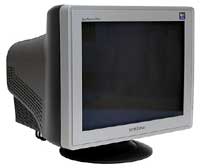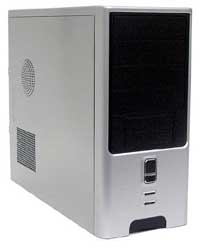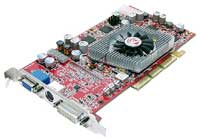AMD Budget Gaming System
If price is your biggest concern, then even $25 for a slightly faster component can be "too much". Such increases add up quickly, and that's what makes this the most difficult price goal to achieve without making compromises. In fact, it really isn't possible to build a "Budget" system that doesn't make some concessions to the almighty dollar. We have done our best, however, to build a system that will be capable of playing all the latest titles at acceptable rates for the next year or two at least. We have a couple of options from the AMD camp as well as one from the Intel side to help you out. We'll start with the absolute cheapest system that we would recommend for gaming, and follow that with a slightly updated system.
| Budget AMD Athlon 64 754 System |
| Hardware |
Recommended Component |
Price |
| Processor |
AMD Athlon 64 2800+ 512K 1.8 GHz (754) |
127 |
| Motherboard |
Chaintech VNF-250 (754) |
73 |
| Memory |
1x512MB Mushkin Basic 2.5-4-4 |
75 |
| Video Card |
Sapphire Radeon 9800 Pro 128 MB 256-bit |
196 |
| Hard Drive |
Seagate Barracuda 80GB EIDE model 7200.7 |
59 |
| Optical Drive |
NEC DVD+/-RW Drive Model 3500A |
72 |
| Case and Power Supply |
Athenatech A602 Black/Silver with 350W PSU |
62 |
| Display |
Samsung 793DF 17 Black/Silver CRT (1280x1024@75 Hz) |
139 |
| Speakers |
Use what you have |
0 |
| Keyboard and Mouse |
Logitech Optical Desktop Combo |
26 |
| Bottom Line |
|
829 |

Click to enlarge. |
The final price comes to a bit more than our $750 target. Unfortunately, it is difficult to get a quality gaming system without making some compromises. We don't include speakers either, on the assumption that most people will have some decent headphones or speakers already available. The same can be said of the monitor: if you already have a monitor with which you are content, you can stick with that for the time being. One nice feature of our Samsung is that it can provide a generally flicker-free 75 Hz refresh rate at its highest 1280x1024 resolution. Unless you need a complete system, those items are the prime candidates for reducing the cost to reach the $750 goal.

Click to enlarge. |
Keyboard and mouse are a personal choice, but we have stuck with the bare minimum for the time being. We prefer Microsoft and Logitech keyboards and mice for a variety of reasons, but they are certainly not the only option; so if your opinion differs from ours, get what you like. The case was one of the more difficult items to select. We like Antec cases for their quality and overall reliability, but there are a huge number of cases from which to choose, so we wanted to give some other options. The Athenatech case comes with a generic 350W PSU, but that will suffice for this configuration. It also has a rear 120mm fan and a cooling duct that sits above the CPU, allowing the HSF to draw in fresh, cool air directly.

Click to enlarge. |
The real core of any gaming system is not the case, speakers and monitor. Those are what others will see, and they may be important from an aesthetic point of view, but if you're only worried about games and you're on a budget, the motherboard, processor, and graphics card are where you want to spend the most money. The socket 754 platform may not have the long-term upgrade options of socket 939, but it does allow us to cut about $50 off the price without sacrificing a whole lot of performance. We have chosen the cheapest Athlon 64 available, the 2800+, which runs at 1.8 GHz. Performance in games is generally better than the Pentium 4 2.8 GHz chips, so the performance rating is deserved. The Sempron 3100+ is also an option that would save us another $20 or so, but we felt that the potential 64-bit enhancements, which should arrive in the next year or so, make it worthwhile, not to mention the larger 512K cache.

Click to enlarge. |
Our choice of graphics card goes to the Radeon 9800 Pro 128 MB. It is important to emphasize that we're looking at the version with a 256-bit memory interface, so make sure you choose the correct model if you want to remain with our selection. There are "9800 Pro" cards now shipping with 128-bit interfaces, and there are also the 9800SE cards that have lower clock speeds and half of the pixel pipelines. For gaming performance, there's almost a linear scaling with the amount of money spent on your graphics card these days. So, if you are willing to turn down some details, you could go with one of the other 9800 variants or even the 9600 Pro or 9600XT, but they are likely to have some issues with upcoming games within the next year or so. For this price bracket, it is also worth mentioning that the 256 MB cards are mostly pointless unless you have a 256-bit memory interface, and that combination tends to cost quite a bit more. If the difference in price between a 128 MB and a 256 MB card is relatively small - i.e. less than $25 - then a card with more RAM might be useful. Otherwise, save your money.
The remainder of the system is pretty much what you've seen us recommend in the past. The 80GB Seagate hard drive comes with a five-year warranty and provides ample storage. Performance differences between the various hard drives really are not that great unless you really spend a lot of money. The DVD+RW drive is our Editor's Choice NEC 3500A from the recent
Fall 16X DVDR Roundup, which provides good performance and features at a very low price. We could have gone with a cheaper optical drive instead of a DVD burner, but we prefer to have a system with CD/DVD burning capability. If you disagree, a DVD-ROM drive can be had for about $25, as can a CD-RW drive. We recommend DVD support for gaming systems, as some of the newer titles are shipping in both DVD and CD versions. Installing from one DVD is much more convenient than installing from four or more CDs, and we can only hope that more games will make the shift to DVDs. We did not include a floppy drive, but for an extra $9, you might want to toss one in just to be safe. There are still some hard drive controllers that require the use of a driver floppy in order to work with the Windows XP installation.














70 Comments
View All Comments
blckgrffn - Tuesday, November 23, 2004 - link
At Newegg, sorry.blckgrffn - Tuesday, November 23, 2004 - link
$35 shipped, 420W thermaltake silent purepower w/18A on the +12 rail - can't beat that. No sense in not upgrading to it in my opinion. Also has two SATA power connectors. It may not be the best, but it is a good brand for low dough, and it regularly retails for under $40. I see no reason not to reccommend it as an alternative, at least.Just my $.02 :-)
JarredWalton - Tuesday, November 23, 2004 - link
I was gone for the weekend due to a personal matter, which is why I have not commented much yet. Basically, the budget segment is extremely difficult to target without cutting some corners. The PSU is definitely one of the corners that was cut. I will certainly agree that a cheap PSU is not the best option, but for a moderate system it should do okay. We do not build and test every one of the systems we recommend here, although we do test the majority of the parts. For the budget system, even a moderate PSU is going to add $50 to the price. It might be worth it, but I would go with the generic for a little while if you're on a tight budget.The mid-range use of the SLK3700-BQE case and PSU is a different story. The 350W Antec PSUs are actually quite good and when paired with that setup I have yet to experience any issues. If you're going to add in a second hard drive and optical drive and try overclocking, it could present a problem, but for the stock recommendation it will work.
I thought I made the PSU situation clear in the article, but looking back I guess it was sort of relegated to a few comments made in the high-end and component summary pages. A good PSU is never a bad investment. Trying to convince someone to spend $75 on a name-brand 400W+ PSU instead of upgrading some other component is difficult to do, unfortunately. I'll make sure I don't overlook this in the future - particularly on the mid-range systems.
Gorion: The component summaries were arranged in order of price, with my suggestion of what budget each component falls into. You'll note that many of the parts do not match up directly with the system we put them in, for example we had to use a "mid-range" priced motherboard for the Intel budget setup. The graphics cards in particular are where we "overspent" - which makes sense for gaming.
You're right on the mouse: the MX510 is the wired version. My bad. Basically, get what mouse you like. I have tried the MX510 before, and while not bad, it's a personal taste. I like the 4th and 5th buttons on opposite sides like the "cheap" MS mice. For precision, Logitech may be better, but I am definitely not hardcore enough to be able to tell the difference between mouse precision on these models. :)
Glassmaster - Tuesday, November 23, 2004 - link
#45: I'm not suggesting that a PSU recommendation should account for overclocking, however, on AMD's offical forums, where I help with Athlon 64 troubleshooting, insufficant PSUs are the most common problem. People are having problems with their PSUs handling stock specifications when they do something demanding, like play a modern game. This is a gaming guide after all...That's why I ask if you build and stress test these systems with the latest games before making a recommendation. If you do, and you find that a particular cheap generic PSU (with less than the consensus recommendation of 18-20A on the 12V rail) works well, that would be good to know. However that has not been my experience.
I wouldn't bother to post at all if I didn't respect this site a lot and enjoy reading it--I would just stop visiting.
Glassmaster.
Wesley Fink - Tuesday, November 23, 2004 - link
RE: The Epox budget board. Jarred had originally selected the Epox budget nf3-250Gb for his budget AMD gamer, but I shared many of the emails I had received re: memory problems with that board. Nothing major, but memory compatibility issues and 4-dimm 333 downclocks not seen with the Chaintech board. While we all agree the Epox has a bit better feature set the Chaintech is known to be rock solid and friendly to just about any memory you feed it. That is the reason for the Chaintech choice for Budget. If you know your memory choice works well with the Epox then by all means choose that board.As an overclocker I have learned the hard way how very important the PS is for Athlon 64 and Socket T Intel. However, most gamers are NOT overclockers - they may overclock the video card but they rarely do much with system overclocking. Given that, Jarred's PS choices make more sense, though I do agree budget Power Supplies are the weakest links in most systems. I'm sure those gamers that "system-overclock" will throw some rocks here, and there are exceptions to every generalization.
thegreatbernie - Tuesday, November 23, 2004 - link
I haven't been able to find the Albatron GeFORCE 6800 GT 256MB GDDR3 for $374. Newegg has it for $455.Gioron - Tuesday, November 23, 2004 - link
Jarred:Two nit-picks, the first being the motherboard chart on the component summary page. The third motherboard down threw me for a second, until I realized it was the third budget motherboard, not the mid-range motherboard it was listed as.
Second, the MX510 is a wired mouse, not wireless. The wireless Ligitech mice are the MX700 and MX1000, the MX510, MX500, and MX300 are all wired mice. I'm guessing you're thinking about the MX700 mouse, which I admit is a bit of an acquired taste, but if you haven't used one before, I'd highly recommend trying out the MX510 before dismissing it.
Disclaimer: I personally use an MX1000 as a replacement to my MX700, but I freely admit its not for everyone.
SDA - Tuesday, November 23, 2004 - link
Damn, I hate to double-post, but I just found something interesting while poking around:http://forums.anandtech.com/messageview.aspx?catid...
Might be worth a read for those of you that don't understand what I have against low-quality power supplies.
SDA - Tuesday, November 23, 2004 - link
#38, no, I guess it doesn't :( No offense to AT, but I doubt they bother-- after all, the PSU is such a trivial piece of hardware, isn't it? Sigh.. anyway, correct me if I'm wrong, but it'd seem that the PSU in the Athenatech case is an L&C unit. Deer/L&C units aren't exactly.. known for their quality.Now, I don't want to seem like I'm sniping, because overall I think this is a pretty good guide. Everyone's going to have their own suggestions and their own favorite parts. A quality PSU isn't something that one would pick just because of their preference, though, it's something one would pick because of their sanity. I've lost count of the number of malfunctioning systems I've seen fixed with replacement PSUs, not to mention how many cheapo power supplies I've seen fail in amusing ways before their time.. picking a cheap PSU to power a solid system is a newbie mistake, it's a shame to see a pro make it.
bofkentucky - Tuesday, November 23, 2004 - link
#39Except it is overpriced, uses an overpriced processor, uses slow ram and is feature limited (No on board SATA). Dothan has potential, but wait until the 915 based dothan boards hit the streets, then you will see a real performance option.